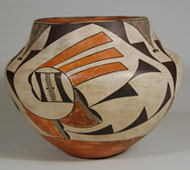Adobe Gallery Blog
Subject: Laguna Pueblo Polychrome Pottery Olla
 It is quite often difficult to distinguish whether a pottery jar is from Acoma or Laguna Pueblo. Refugees from Acoma and other pueblos established Laguna Pueblo a few years after the Pueblo Revolt of 1680. As a result, its pottery is very similar to that of Acoma Pueblo, and, for the most part, is indistinguishable from Acoma ceramics. Sometimes, designs can be a distinguishing factor.
It is quite often difficult to distinguish whether a pottery jar is from Acoma or Laguna Pueblo. Refugees from Acoma and other pueblos established Laguna Pueblo a few years after the Pueblo Revolt of 1680. As a result, its pottery is very similar to that of Acoma Pueblo, and, for the most part, is indistinguishable from Acoma ceramics. Sometimes, designs can be a distinguishing factor.
The black and white squares inside the spiral curve of this jar are often seen on Laguna jars. Sometimes they are split rectangles. In this case, they are split by three parallel lines outlined by dots on the outer lines. The double black dots (that look similar to sunglasses) extended from the fine line triangles on the body design are almost always associated with pottery from Laguna. Lastly, the openness and simplicity of the design is more a characteristic of Laguna than Acoma wares.
Using one's imagination, it is easy to see that the design is a stylized bird element. The curved line is the head of the bird, the black and white square represents the eyes, the three parallel orange bars are head feathers and, finally, the curved triangles below are either body feathers or perhaps clouds over which the bird is flying. There are three of these designs around the jar.
The jar has an orange color underbody and a two-inch wide orange band inside the neck. There is a black rim without a ceremonial line break, but, looking carefully at the framing line below the rim, one sees a ceremonial break in the triangle element comprised of parallel fine lines.
Condition: very good condition
Provenance: from the estate of Reggie Sawyer, the Hanging Tree Gallery, Albuquerque
Recommended Reading: Acoma & Laguna Pottery by Rick Dillingham (1952-1994)
Subject: Laguna Pueblo Polychrome Pottery Olla
Potter Unknown
Category: Historic
Origin: Laguna Pueblo
Medium: clay, pigment
Size: 8-1/4" tall x 10-5/8" diameter
Item # C3385C

